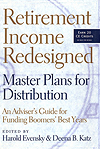Bombarded with articles about the aging boomers’ plight with little in- depth discussion of solutions, advisers are given a great opportunity in this book to learn about the core issues and the solutions to helping their clients achieve a lifelong retirement income plan with less reliance on luck. Clients are facing ever-increasing risks to their long term financial well being and this problem is becoming far more difficult to solve. In the midst of this daunting challenge, lies an awesome opportunity for the advisers who do their homework.
Evensky and Katz have pulled together many of the brightest in the field from academics to boots-on-the-ground advisers to clearly illuminate the problems and offer a wide variety of solutions to even the thorniest issues:
- Sustainable withdrawals
- Longevity risk
- Eliminating luck as a factor in planning
- Strategies for increasing retirement cash flow
The book is divided into three sections.
Part One | Facing the New Realities– This 4 chapter section covers Boomer data and an overview of how advisers can adjust their practice to meet the challenge of the boomers’ changing needs. Less than 10 years ago, retirement income came mainly from Social Security and defined-benefit plans. The trend toward defined-contribution plans and the increase in longevity now make the danger of coming up short very real. Nearly three quarters of pre-retirees, in a recent poll, had not done a budget of their anticipated income and expenses in retirement; hadn’t set an asset allocation strategy for managing their retirement income and had not decided which sources to tap first for income once they retire. The process of generating a steady income from savings remains a hazy notion at best to most people.
Part Two | Assessing the Risks– The next 5 chapters address the retirement distribution risks from the psychological risks to the risks of realistic assumptions about retirement income and the probabilities used in distribution analysis and safe withdrawal rates. Robert Curtis, the developer of MoneyGuidePro, authors a great chapter named Monte Carlo Mania where he demystifies Monte Carlo and addresses some of the problems inherent in using Monte Carlo in financial planning. Curtis believes the benefits of Monte Carlo simulations have been oversold. “Good software can make it easier to do complex things, but it can’t magically transform the complex into the simple.” The software programs that use Monte Carlo must
1) project results far into the future and 2)make assumptions that reflect the opinions and biases of the software designers. Change the assumptions a little, and the results will change a great deal. Monte Carlo assumes that no changes are made to the plan over its entire 30 year span, as if you and your client are on automatic pilot. Curtis claims that if Monte Carlo is used properly is can provide additional information that can be helpful to client education but it is never sufficient by itself. Stress testing, an alternative to Monte Carlo, is both easier to use and more effective. When setting the retirement distribution plan the advisor asks more than the traditional question of “How much income do you need in retirement?” The goal setting is more of a complete lifestyle goal summary that is prioritized. From this prioritized goal summary you create a base plan that funds the goals in priority order. You stress test the plan for return-sequence risk in addition to the unsystematic risks that Monte Carlo can’t test for: long term care, concentrated stock and longevity. If the client understands the plan, believes in it and is prepared for its inherent risks they are likely to stick with it over the long term through good and bad years.
Part Three | Shaping the Solutions– 11 chapters are dedicated to solutions from creating portfolios with lower volatility to strategies for increasing retirement cash flow and providing sustainable withdrawals. Harold Evensky contributes a chapter on Withdrawal Strategies where he features the Evensky & Katz Cash Flow Reserve Strategy. First Evensky exposes the flaws in a traditional income portfolio and a reverse dollar-cost averaging from market investments. Then he outlines Evensky and Katz’s Cash Flow Reserve’s straightforward approach. Establish three separate accounts. One is the cash flow reserve portfolio which holds two years of cash flow reserves. The second is the investment portfolio which is invested and monitored without the risk of needing to provide liquidity which is covered by the cash flow reserve. The third is the local checking account which you place an agreed upon monthly income from your cash flow reserve. This strategy minimizes the frequency of transactions (reducing transaction costs) and enables an adviser to manage more efficiently the tax consequences of funding the client’s cash flow needs. Cash flow to the client is consistent and independent of market volatility. The source of the cash flow is visible and reliable (money market and short-term high-quality municipal bonds). Clients understand the strategy, and it frames the accounts in a manner consistent with a client’s separate-pocket mentality.
A great read and a great resource, Retirement Income Redesigned is full of innovative ideas giving perspective to advisers not only on putting this new age of retirement in context, but for positioning their practices as well.
The book offers 20 hours of CE credit for your CFP CE requirement with an on line registration. www.bloomberg.com/books




Great review! And I need the CE credits!